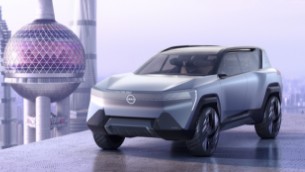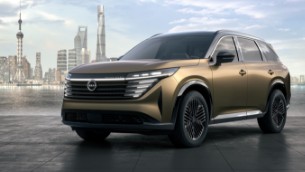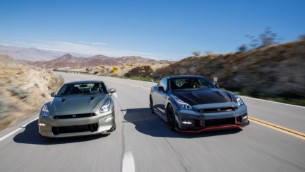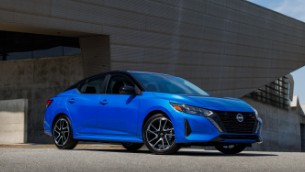Crash Avoidance Robotic Car Inspired by Flight of the Bumblebee
What better way to advance the development of crash prevention technology than to mimic some of the best proponents of collision avoidance in the natural world? Bees.
In a surprising project that will be unveiled at CEATEC, the humble bumblebee has given engineers at Nissan Motor Co.'s Advanced Technology Center a strategic hint at how to design the next generation of crash-avoidance systems.
Based on joint research with the Research Center for Advanced Science and Technology at Japan's prestigious University of Tokyo, Nissan has built the Biomimetic Car Robot Drive, or BR23C. It is a robotic micro-car that recreates bee characteristics with the goal of producing a system that prevents collisions altogether. BR23C is one of many new safety technologies that Nissan is working as part of its 'Safety Shield' concept – an advanced, proactive approach to safety issues based on the idea that cars should help protect people. The approach classifies driving risks and accidents into six stages. It is Nissan's goal to halve the number of automobile accident fatalities or serious injuries involving its vehicles by 2015 compared to 1995.

"The BR23C robotic car is positioned as the inner-most layer of this shield. We are expecting that this robotic car will support the development of future collision-avoidance technologies," said Mitsuhiko Yamashita, Executive Vice President in charge of research and development.
In flight, each bee creates its own oval-shaped personal space which in fact closely resembles Nissan's Safety Shield concept.
But more crucially, it is the bee's compound eyes, capable of seeing more than 300-degrees that allows the bumblebee to fly uninterrupted inside its personal space. In order to recreate the function of a compound eye, engineers came up with the idea of a Laser Range Finder (LRF).
The LRF detects obstacles up to two meters away within a 180-degree radius in front of the BR23C, calculates the distance to them, and sends a signal to an on-board microprocessor, which is instantly translated into collision avoidance.
"The split second it detects an obstacle, the car robot will mimic the movements of a bee and instantly change direction by turning its wheels at right angles or greater to avoid a collision," explained Toshiyuki Andou, Manager of Nissan's Mobility Laboratory and principal engineer of the robot car project.
"The biggest difference to any current system is that the avoidance maneuver is totally instinctive. If that was not so, then the car robot would not be able to react fast enough to avoid obstacles," Andou said.
"It must react instinctively and instantly because this technology corresponds to the most vulnerable and inner-most layer of our Safety Shield, a layer in which a crash is currently considered unavoidable," he added. "The whole process must mirror what a bee does to avoid other bees. It must happen within the blink of an eye."
But unlike a bee, it cannot deviate upwards or downwards or diagonally, only in two dimensions and only in the direction that the wheels can turn.
"So in place of the infinite number of ways a bumblebee can avoid other bees, we have employed a rotation function, in addition to acceleration and deceleration as our car robot's means of collision avoidance," Andou said.
Andou tells us that its instincts are intelligent, not its ability to process or even store data.
"This device only needs to process inputs every few seconds, and act on that," he said. "It does not require a huge central processing unit to run complicated programs or a large memory to store enormous data from previous maneuvers.It can operate continuously using an extremely simple microprocessor."
This research might have only just begun with the biomimetic car robot, but this bee-inspired technology has taken the next big step in creating technologies that may help one day lead to a collision-free future.
Other major exhibits
· Keynote Speech Minoru Shinohara, SVP in charge of R&D will make a presentation on " The Future of Automobile with Car Robotics Evolution and Communication Technology." on Oct. 1 from 11:00 to 12:00 in Convention Hall B.
· Mobile Phone with Built-in Intelligent Key Co-developed with NTT DOCOMO and Sharp, Nissan will unveil a mobile phone capable of functioning as an intelligent key for automobiles – a world's first. The device will incorporate Nissan's Intelligent Key system, a keyless entry system already featured in various Nissan vehicles. This is expected to go on-sale in early fiscal year2009.
· Robotic Agent Pre-register your photo of your face with the robotic agent, and through face-recognition technology, it will welcome you like a friend and supply information tailored to your personal interests. Combining Nissan's CARWINGS and the pivo-kun robot, the robot agent will also guide drivers to popular tourist spots. The robotic agent Pivo-kun was featured on the Pivo 2 concept car revealed at Tokyo Motor Show 2007.
· Eco-drive Training@CEATEC Professional Nissan test drivers will give visitors advice on fuel-efficient driving skills at a special driving course beside the exhibition hall. Visitors also can experience Nissan's newly developed "ECO Pedal" technology which is installed in a prototype vehicle. ECO Pedal is a world's-first technology designed to assist drivers in operating their vehicles more efficiently.










